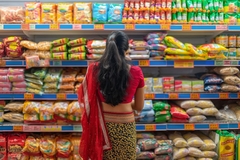
- Industry news
Industry news
- Category news
Category news
- Reports
- Key trends
- Multimedia
- Journal
- Events
- Suppliers
- Home
- Industry news
Industry news
- Category news
Category news
- Reports
- Key trends
- Multimedia
- Events
- Suppliers
Puratos harnesses AI to unlock tomorrow’s tastes and elevate food innovation
The bakery ingredient supplier unraveled emerging trends in an exclusive event attended by Food Ingredients First

19 Sep 2024 --- “Dynamism, pleasure and health” — three words highlighted by Jules Darvill, managing director at Puratos, at its Taste Tomorrow event earlier this week in Chipping Norton, UK. Speaking during the opening of the event, Darvill underscores that future food innovation is expected to capitalize on ways that elevate nourishment while sustaining health and improving one’s quality of life.
Meanwhile, artificial intelligence (AI) is expected to fuel healthy lifestyles, with speakers urging F&B players to embrace AI as a tool to take food innovation to the next level.
“It’s in our DNA to care about the behaviors and psychology and the interactions of consumers through food. We are living in a world that is moving fast,” states Darvill. “So now, as industry professionals, we favor what we call an ‘always on’ approach.”

“Using AI we’re able to stream, guide, nose through and percolate all of the things that we see on social media and blogs and present you an ‘always on’ look on what consumers are talking about when it comes to food.”
AI-powered trend analysis
Among the event’s speakers, Pete Dunn, sales director, explains how an AI model analyzes data specifically around bakery, patisserie and chocolate applications.
“Our trained AI model looks at content from social media sites, blogs and review sites. There’s a lot of data, it adds up to around 200,000 posts per day, such as any interactions, likes, a comment or a share. These interactions help us to identify what is most appealing to consumers.” Pete Dunn, sales director, explains how AI can analyze data specifically around bakery, patisserie and chocolate applications.
Pete Dunn, sales director, explains how AI can analyze data specifically around bakery, patisserie and chocolate applications.
Philippa Knight, marketing director, explains: “We have trained an AI model to focus on online content specifically in Bakery, Patisserie and Chocolate. So all of the data that we’re creating is relevant to the categories that we want to know more about.”
However, Knight remarks that “we still need human intelligence in order to interpret data to spot where AI might be making a mistake or picking up something false.”
She says: “It’s up to us to train the AI models to give us the information that we need.”
“Using this data, we can then see what is talked about the most and actually, what people are increasingly talking about.” This ultimately paves the way for future trends, according to Puratos.
During the Q&A session, Food Ingredients First asked: “What are the risks of missing data from groups of demographics that perhaps aren’t active on social media?”
“You can’t purely rely on one source of data,” replies Knight, “That’s why it’s great to look at trends on social media, but we still need to do focus groups and surveys. We still need to do shop-alongs in supermarkets, that kind of human element of research is just as important as ever.”
“But with AI, we have this extra tool to help us look at trends, but regardless of whether or not somebody is interacting on social media, they will still get swept along with the societal trends that social media brings about,” continues Knight.
High-growth areas
Knight notes that with knowledge from AI, “tech-inspired” is a very high-growth trend.
“When we look at megatrends, like ultimate convenience and digital disruption, these trends are all about the experience we have with food that is outside of the actual eating of the food,” she says.
“It’s got nothing to do with the taste of the food at all. It’s essentially the ingredients, the process of purchasing, the dining experience and it can even relate to the interaction and the engagement that we have with brands.”
All these factors are being “heavily influenced” by advancements in technology, she adds.
Future insights
During her presentation, guest speaker and food futurologist Dr. Morgaine Gaye shares that “food is connected to everything” and that trends in food allow us to “look into the future.” Dr. Morgaine Gaye, a food futurologist, discusses the expected trends in food in food innovation. She highlights a growing interest in the “imperfections of nature.”
Dr. Morgaine Gaye, a food futurologist, discusses the expected trends in food in food innovation. She highlights a growing interest in the “imperfections of nature.”
“Right now, we’re living in unstable times, geopolitically and economically. It’s a difficult time for people and businesses.”
Looking ahead to 2025 and 2026, Gaye predicts consumers will be looking for a sense of security. “We’re going to be looking at algorithms and data that provide us with some kind of an anchor.”
Inspired by nature
Meanwhile, Gaye observes that during the height of the COVID-19 pandemic, “all consumers had was nature.”
But one interesting thing that she has seen more of is the imperfections in nature and how these are represented in baked, patisserie and chocolate goods.
While showing some examples of futuristic food images on screen, Gaye discusses one with an oxidizing apple core. She believes this shows the “true, unadulterated version of nature.”
“That’s what realness is, and one thing consumers are more open to is this idea of imperfection with nature. They are understanding of the intelligence in nature.”
“It’s not just pretty and perfect. We’re seeing food being represented more wildly, for instance, with brambles and earthiness, these things are showing up in flavor and patterns. We see bitter flavor profiles and the darkness of nature, perhaps shown in rocks or shapes that feel much darker and dystopian.”
Acknowledging these insights, Puratos presented a range of baked and sweet goods at the Taste Tomorrow event at its marketplace. Among the innovations developed by Puratos chefs, they showcased a 50/50 Rainbow Veg Bread, which was “designed with families in mind to encourage children to eat healthier breads,” one of the chefs tells Food Ingredients First.
 50/50 Rainbow Veg Bread was designed by Puratos to offer healthier bread alternatives for children.The bread features colorings from beetroot and carrot and is embossed with wildflowers on the side of the loaf. The outcome is a visually attractive, yet rustic loaf that will appeal to consumers looking to “reap the benefits from nature.”
50/50 Rainbow Veg Bread was designed by Puratos to offer healthier bread alternatives for children.The bread features colorings from beetroot and carrot and is embossed with wildflowers on the side of the loaf. The outcome is a visually attractive, yet rustic loaf that will appeal to consumers looking to “reap the benefits from nature.”
Viewing waste as wealth
Meanwhile, “waste as wealth” was also highlighted as a future trend, as was putting the “eco back in economy.”
Repurposing waste streams or giving items a new meaning is expected to be one of the key trends of the future, notes Gaye.
“Products that are being created must have added value or purpose to another area of innovation,” she shares. “It has to have a second meaning, whether that’s health or a vessel or container that can be reused and repurposed because conscious consumerism will only become more apparent.”
“A lot more nature-based products are coming through because of the wasteless trend,” Gaye states. “Ways in which we can repurpose byproducts from the food industry are being seen in big fashion brands, such as silks made from orange peel and fabrics made from the waste of the milk or yogurt-making process.”
“Upcycling gives brands an opportunity also to create more money, which is a double-edged bonus,” she concludes.
By Elizabeth Green










